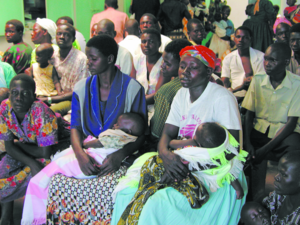
According to the recently conducted national survey in 2024, Uganda's population stands at 45.9 million.[1] Health status is measured by some of the key indicators such as life expectancy at birth, child mortality rate, neonatal mortality rate and infant mortality rate, maternal mortality ratio, nutrition status and the global burden of disease. The life expectancy of Uganda has increased from 39.3 in 1950 to 62.7years in 2021.[2] This is lower below the world average which is at 71.0 years.[3] The fertility rate of Ugandan women slightly increased from an average of 6.89 babies per woman in the 1950s to about 7.12 in the 1970s before declining to an estimate 4.3 babies in 2019.[4] This figure is higher than the world average of 2 and most world regions including South East Asia, Middle East and North Africa, Europe and Central Asia and America.[5] The under-5-mortality-rate for Uganda has decreased from 191 deaths per 1000 live births in 1970 to 41 deaths per 1000 live births in 2022.[1]

The Human Rights Measurement Initiative found that Uganda is fulfilling 80.0% of what it should be fulfilling for the right to health based on its level of income.[6] Total health expenditure as a percentage of gross domestic product (GDP) was 4.67% in 2021.[2]
- ^ "Uganda's population jumps by 11.3m as growth rate declines". The East African. 29 June 2024. Retrieved 16 September 2024.
- ^ Dattani, Saloni; Rodés-Guirao, Lucas; Ritchie, Hannah; Ortiz-Ospina, Esteban; Roser, Max (28 December 2023). "Life Expectancy". Our World in Data.
- ^ Dattani, Saloni; Rodés-Guirao, Lucas; Ritchie, Hannah; Ortiz-Ospina, Esteban; Roser, Max (28 December 2023). "Life Expectancy". Our World in Data.
- ^ Roser, Max (12 March 2024). "Fertility Rate". Our World in Data.
- ^ "Gapminder Tools". www.gapminder.org. Retrieved 11 September 2021.
- ^ "Uganda - Human Rights Tracker". rightstracker.org. Retrieved 1 May 2023.